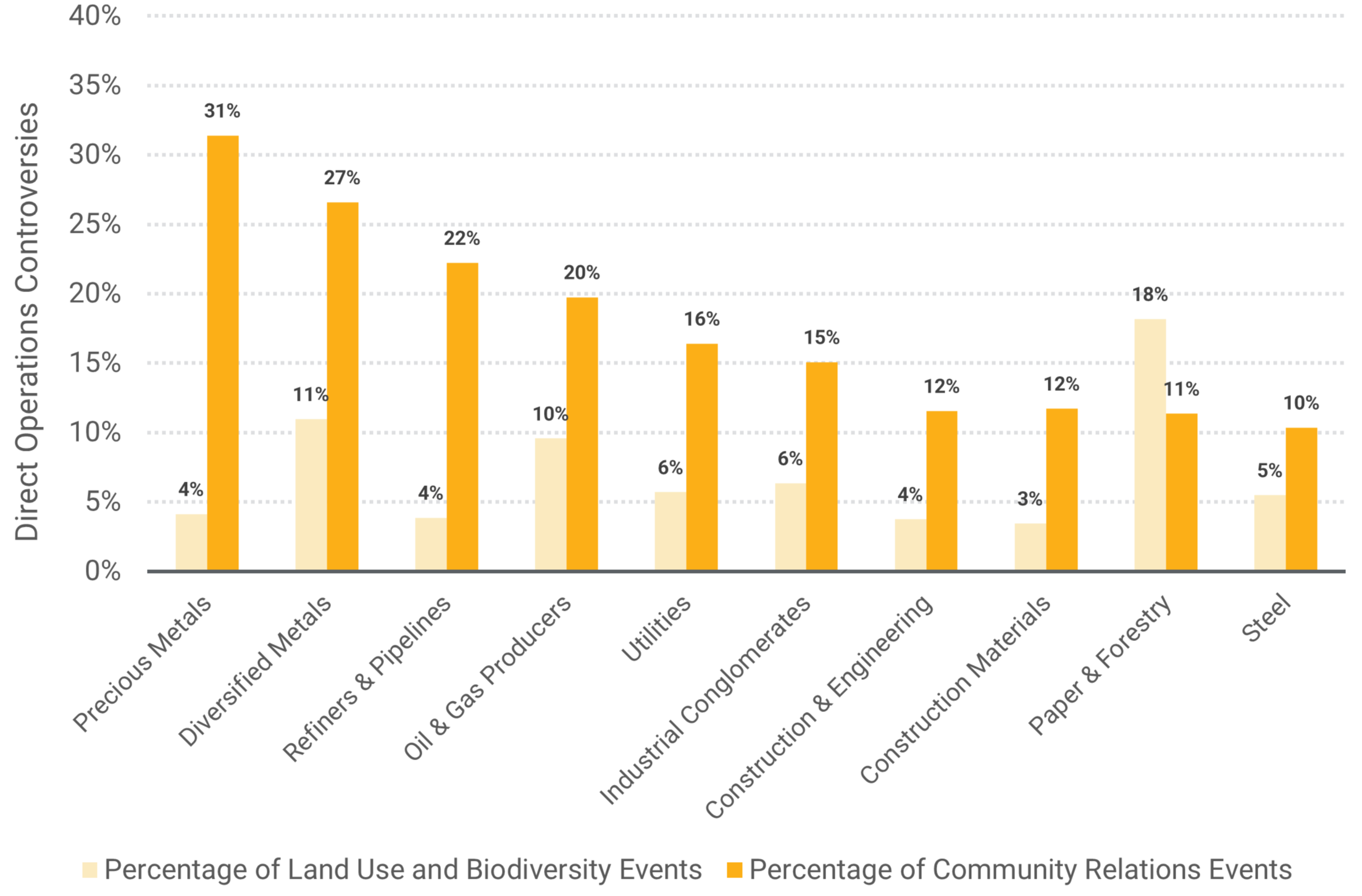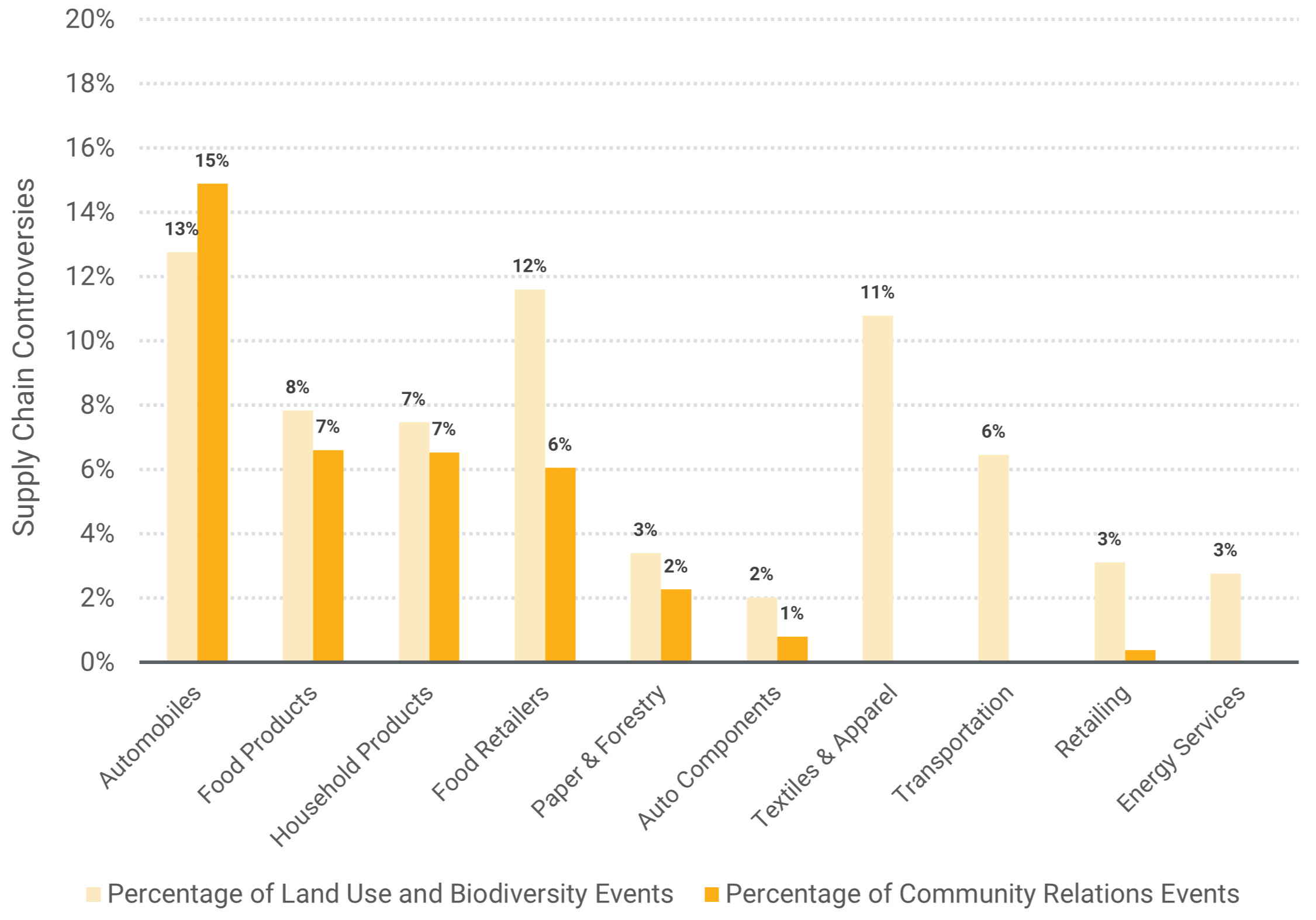The current trajectory of biodiversity loss and ecosystem degradation1 poses significant risks to both companies and financial institutions.2 In a previous article, we explored how biodiversity loss exposes corporate entities to both physical and transition risks. However, to successfully manage biodiversity-related risks, companies must engage with and explicitly recognize the rights of indigenous peoples and local communities (IPLC).
Acknowledging the pivotal role IPLCs play in biodiversity management is not only ethically sound, but also critical to effectively addressing biodiversity-related risks. An analysis based on Morningstar Sustainalytics' Controversies Universe found a correlation between companies entangled in biodiversity and community relations controversies, highlighting the interconnectedness of the issues and the need to address them together. Despite this, the connection between the two is often missed.
IPLCs’ Crucial Role as Custodians of Biodiversity
IPLCs’ territories often overlap with the world’s most biodiverse areas, comprising approximately 40% of all terrestrial protected areas.3 Their coexistence with nature and their traditional land management practices4 have resulted in 91% of IPLC lands being in good or moderate ecological condition.5 Despite their considerable role in biodiversity conservation, these groups have lacked support and legal recognition of their role. Acknowledging IPLCs as rights-holders and involving them in decision making processes is essential to effective conservation efforts.
The importance of IPLCs has been acknowledged in the Kunming-Montreal Global Biodiversity Framework (GBF). It emphasizes respecting and preserving the rights, knowledge, values and practices of IPLCs during its implementation. Several targets of the framework specifically highlight the importance of respecting IPLC rights over their traditional territories and their customary use of natural resources. Target 22 of the GBF underscores the need for equitable and inclusive representation and participation in biodiversity-related decision making, and respecting the culture, rights and knowledge of IPLCs.6 A fund has now been established by the Global Environment Facility to support the implementation of the GBF and provide enhanced access for IPLCs.7
The recently released Taskforce on Nature-related Financial Disclosures (TNFD) also sends a clear message that the engagement of IPLCs is integral to the assessment and management of nature-related risks and opportunities. Specifically, the TNFD’s general requirement 6 states that an, “organisation should describe its process for engaging Indigenous Peoples, Local Communities and affected stakeholders about their concerns and priorities with respect to nature-related dependencies, impacts, risks and opportunities in its direct operations and value chain.”8
One of the recommended governance disclosures asks users to report on board and management oversight with respect to IPLCs when addressing nature-related issues. In addition, engagement with IPLCs is a core component throughout the TNFD’s guidance for identifying and assessing nature-related issues (the LEAP approach). To support meaningful engagement with IPLCs, the TNFD has published this guidance document.
Analysis of Biodiversity and Community Relations Controversies
The analysis below focuses on companies’ biodiversity and community relations controversies.9 A company can have negative environmental and social impacts not just through its direct operations, but across its value chain. For some industries, the most impactful activities are likely to be embedded within their supply chains. Therefore, we have conducted the analysis in two parts to highlight the controversies associated with companies’ direct operations, as well as their supply chains.
To understand whether there was a correlation between companies facing biodiversity controversies and those facing community relations controversies, we looked at the correlation coefficient. This is a number ranging from -1 and 1 and indicates the strength and direction of a relationship between two variables. We observed a positive correlation between biodiversity and community relations controversies within both supply chains (0.59) and direct operations (0.38). Despite the potential overlap between biodiversity and community relations, our analysis underscores that even when assessed independently, companies facing biodiversity controversies are more likely to encounter community relations issues.
Figure 1 highlights the 10 industries with the highest percentage of combined controversies in biodiversity and community relations within their direct operations. This analysis encompasses controversies across all impact levels (low to severe).
Among these industries, the precious metals industry exhibits the highest percentage of companies associated with community relations controversies, amounting to 31%. Additionally, the paper and forestry and diversified metals industries stand out for having over 10% of companies implicated in both biodiversity and community relations controversies.
Figure 1. Industries With the Highest Percentage of Direct Operations Biodiversity and Community Relations Controversies

Source: Morningstar Sustainalytics. For informational purposes only.
Note: The data for this analysis was retrieved on August 25, 2023 from Sustainalytics Controversies Universe using the event indicators “Land Use and Biodiversity” and “Community Relations.”
Within the supply chain, the automobiles industry surpasses other industries in the percentage of companies associated with both biodiversity (13%) and community relations (15%) controversies. This underscores the necessity of scrutinizing a company’s supply chain impacts (see Figure 2 below).
Figure 2. Industries With the Highest Percentage of Supply Chain Biodiversity and Community Relations Controversies

Source: Morningstar Sustainalytics. For informational purposes only.
Notes: The data for this analysis was retrieved August 25, 2023 from Sustainalytics Controversies Universe using the Event indicators “Land Use and Biodiversity - SC” and “Community Relations- SC.”
Delving into industries associated with either high (Category 4) or severe (Category 5) impact events, our analysis revealed that the paper and forestry industry had the most significant biodiversity-related controversies, where 6% of companies in this industry are associated with high or severe controversies. Meanwhile, the industries of precious metals and diversified metals had the highest percentage of high or severe impact events tied to community relations.
The Way Forward Through a Holistic Approach
As our data highlights, biodiversity and community relations are interconnected. Therefore, when addressing biodiversity risk, investors should consider social indicators.
To do this, institutional investors can screen for companies in key industries with weak policy indicators as well as a history of controversies. Investors can engage with companies identified as poor performers to mitigate risks and explore opportunities. In addition, we encourage investors to advance the agenda on biodiversity and social issues by participating in multi-stakeholder initiatives and collaborating with other financial institutions to share knowledge as well as with leading companies to understand current best practice.
Contact us to learn how Morningstar Sustainalytics’ thematic engagements can support your company dialogues on the issues of biodiversity and human rights.
References
- IPBES. 2019. “Global Assessment Report on Biodiversity and Ecosystem Services of the Intergovernmental Science-Policy Platform on Biodiversity and Ecosystem Services.” https://www.ipbes.net/global-assessment.
- Dasgupta, P. 2021. “The Economics of Biodiversity: The Dasgupta Review.” February 2, 2021. https://www.gov.uk/government/publications/final-report-the-economics-of-biodiversity-the-dasgupta-review.
- Garnett, S. et al. 2018. “A spatial overview of the global importance of Indigenous lands for conservation.” Nature. July 16, 2018. https://doi.org/10.1038/s41893-018-0100-6.
- Sobrevila, C. 2008. “The Role of Indigenous Peoples in Biodiversity Conservation.” World Bank. May 1, 2008. https://documents.worldbank.org/en/publication/documents-reports/documentdetail/995271468177530126/the-role-of-indigenous-peoples-in-biodiversity-conservation-the-natural-but-often-forgotten-partners.
- WWF et al. 2021. “The State of Indigenous People’s and Local Communities’ Lands and Territories: A technical review of the state of Indigenous Peoples’ and Local Communities’ lands, their contributions to global biodiversity conservation and ecosystem services, the pressures they face, and recommendations for actions.” https://wwfint.awsassets.panda.org/downloads/report_the_state_of_the_indigenous_peoples_and_local_communities_lands_and_territor.pdf.
- Convention on Biological Diversity. 2022. “COP15: Final Text of Kunming-Montreal Global Biodiversity Framework.” Official CBD Press Release, December 22, 2022. https://www.cbd.int/article/cop15-final-text-kunming-montreal-gbf-221222.
- Convention on Biological Biodiversity. 2023. “Launch of the Global Biodiversity Framework Fund”. Official CBD Press Release, August 22, 2023. https://www.cbd.int/article/launch-global-biodiversity-framework-fund
- TNFD. 2023. " Guidance on engagement with Indigenous Peoples, Local Communities and affected stakeholders.” September 2023. https://tnfd.global/wp-content/uploads/2023/08/Guidance_on_engagement_with_Indigenous_Peoples_Local_Communities_and_affected_stakeholders_v1.pdf?v=1695138220.
- Morningstar Sustainalytics’ ESG research methodology assesses company controversies into five categories. Category 1 controversies have the lowest environmental and social impact and risks to the company are minimal. Category 5 controversies have a severe impact on the environment and society and pose serious business risks. To learn more visit: https://www.sustainalytics.com/investor-solutions/esg-research/controversies-research.




